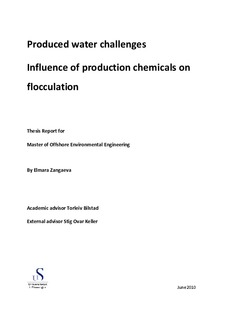| dc.description.abstract | Produced water is the largest volume waste from offshore oil and gas exploration and production processes. Water in varying quantities is always produced along with oil, and has to be separated from the oil. The quantity of “produced water” generally increases substantially with the age of the oil field. Produced water handling tactic depends on the composition of produced water, location, quantity and the availability of resources.
This thesis describes practical, economical, technological and environmental aspects of produced water management, an incorporated part of the oilfield development plan. The water can either be injected into the formations or treated. Advantages and disadvantages of different options for produced water minimizing technologies are discussed.
Water is mostly discharged to sea. Treatment of produced water has been attempted and is proven to be an effective option for produced water handling. After treatment it, however, still contains traces of oil and chemicals. In addition, some oil is discharged with displacement water. Reducing environmental impact of produced water discharges is the major aim of each oil and gas production field.
In Norway PW discharge is under strict authority of the Pollution Act, which gives permits for discharge to the environment, The Oslo-Paris convention, OSPAR, is the most important international agreement regulating discharges to the sea and protecting marine environment of the north-east Atlantic. OSPAR stipulates that the maximum discharge limit is 30 ppm OIW for the petroleum companies operating in the North-East Atlantic. In order to meet zero environmental harmful discharges a produced water management tool Environmental Impact Factor (EIF) was developed.
When choosing produced water treatment technologies, focus is on the major contributor for the total environmental impact. Experience has shown that the major contributors to EIF are dispersed oil, volatile aromatics, heavy aromatics, alkylated phenols, and different process chemicals. ... | en_US |
